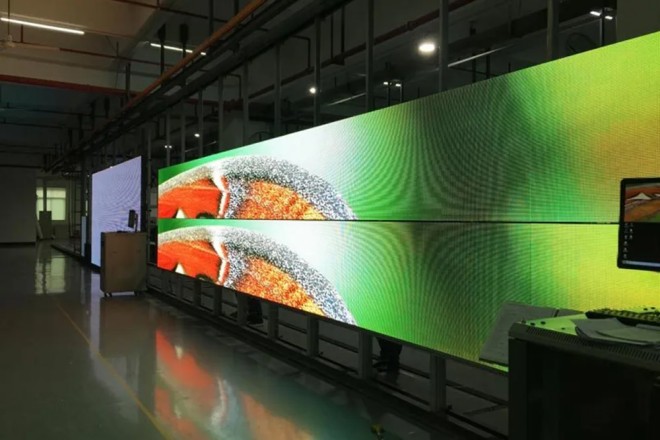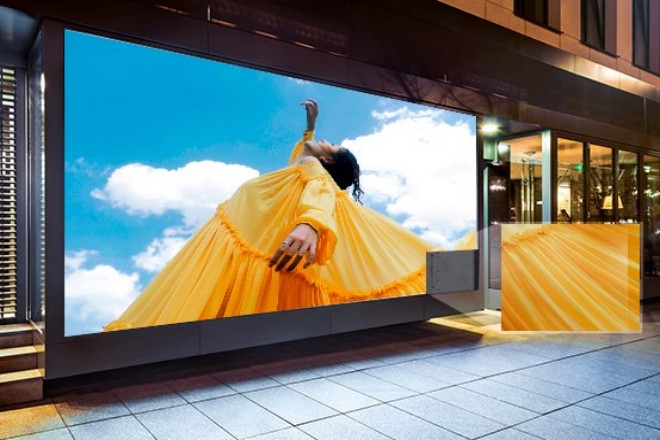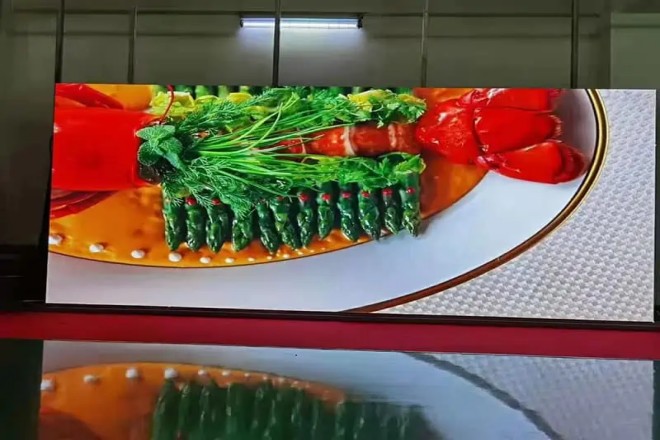Introduction

Écrans d'affichage LEDGrâce à leurs excellents effets d'affichage et à leurs capacités d'assemblage flexibles, les écrans plats sont devenus la référence en matière de technologie d'affichage moderne. Cependant, le problème des espaces d'assemblage est comparable à un défaut dans un beau jade, affectant la cohérence visuelle et l'esthétique générale.
Cet article vise à analyser en profondeur les causes des écarts d'épissure des écrans LED et à explorer des solutions efficaces afin de promouvoir le développement et l'amélioration de la technologie d'affichage LED.
1. Quel impact l'espace dans l'écran LED a-t-il sur l'effet d'affichage ?

L'impact des espaces entre les écrans LED sur les effets d'affichage est une question complexe et multidimensionnelle. Elle est non seulement liée à la précision technique, mais aussi directement liée à la perception visuelle et à l'expérience globale du public.
1). Perturbation de la continuité visuelle
L’existence d’espaces dans l’affichage LED affectera considérablement la continuité visuelle de l’image.
Lorsque vous vous tenez devant un grand écran composé de plusieurs petits morceaux, si les espaces entre ces petits morceaux sont clairement visibles, votre ligne de vue sera interrompue par inadvertance par ces espaces et vous ne pourrez pas comprendre l'image.
Cette incohérence visuelle non seulement réduit l'attrait de l'image, mais peut aussi dérouter et gêner le spectateur. Surtout lorsqu'il s'agit d'images dynamiques ou de scènes complexes, la présence de trous donne à l'image un aspect fragmenté, rendant difficile la restitution de la fluidité et de la vivacité attendues.
2). Limité angles de vision
L'écartement impose également certaines restrictions sur les angles de vision. Comme il peut produire des effets visuels différents selon l'angle, il peut être particulièrement visible sous certains angles, ce qui peut affecter l'expérience visuelle.
Cette limitation est particulièrement évidente lors d'événements ou d'expositions de grande envergure, car le public a tendance à venir de toutes les directions et à avoir des angles de vue différents. Si l'espace entre les écrans n'est pas géré correctement, certains spectateurs peuvent être déçus, car ils ne bénéficient pas du meilleur angle de vue.
- Distorsion de l'image et écart de couleur
De plus, les espaces vides peuvent entraîner une distorsion de l'image et des variations de couleur. Chaque petit morceau d'écran pouvant présenter de subtiles différences de luminosité, de saturation des couleurs, etc., ces différences, une fois assemblés, créeront des contrastes évidents dans les espaces vides.
Non seulement ce contraste rend l'image peu naturelle, mais il peut également faire douter le spectateur de l'authenticité du contenu affiché. Surtout dans les situations où des couleurs et des détails précis sont requis, comme lors d'expositions d'art ou de démonstrations scientifiques, la présence de trous peut nuire à l'affichage dans son ensemble.
3). Impact négatif sur l'esthétique générale et l'image professionnelle
Les espaces vides auront également un impact négatif sur l'esthétique générale et l'image professionnelle de l'écran LED. Un écran bien conçu doit capter l'attention du public et transmettre un message professionnel et haut de gamme.
Cependant, cette image professionnelle est compromise si l'affichage présente des lacunes visibles. Les spectateurs peuvent penser que la qualité de l'affichage n'est pas à la hauteur, ce qui crée un sentiment de méfiance envers le contenu affiché.
Lors d’événements professionnels ou de conférences, ce sentiment de méfiance peut avoir un impact supplémentaire sur l’image et la réputation d’une marque.
2. Quelles sont les causes des écarts dans l’épissure des écrans LED ?
1). Détails de conception et de fabrication
- Tolérance de taille de la carte unitaire :
Chaque carte LED est comme une petite pièce de puzzle, et sa taille doit être très précise pour s'assembler parfaitement. Cependant, en production réelle, en raison des limitations des procédés et des équipements, de légères différences de taille peuvent apparaître entre les cartes, de l'ordre de 0,1 mm ou moins. Une fois ces cartes assemblées, ces minuscules différences s'accumulent et créent les espaces visibles.
- Largeur du cadre et connecteurs :
La largeur du cadre du module LED est également un facteur clé influençant la taille de l'espacement. Si le cadre est trop large, les espaces formés lors de l'épissure seront plus visibles.
De plus, la précision des pièces de connexion (telles que les supports, les vis, etc.) et les erreurs d'installation peuvent également affecter la taille de l'espace. Par exemple, une tolérance du connecteur supérieure à 0,05 mm ou un alignement incorrect lors de l'installation peuvent entraîner des espaces.
2). Matériaux et facteurs environnementaux
- Dilatation et contraction thermiques :
Les différents matériaux se comportent différemment en cas de dilatation et de contraction thermiques. Les matériaux de fabrication des écrans LED, tels que les panneaux et les cadres, produisent de légères variations dimensionnelles en fonction de la température.
Si les coefficients de dilatation et de contraction thermiques de différents matériaux sont très différents, par exemple, lorsque la température change de 10 degrés Celsius, un matériau se dilate de 0,2 mm, tandis que l'autre matériau ne se dilate que de 0,1 mm, des espaces peuvent alors se produire au point d'épissure.
- Utilisation et usure à long terme :
Lors d'une utilisation prolongée, chaque composant de l'écran LED subit une certaine usure et déformation. Par exemple, les connecteurs peuvent se desserrer ou s'user, entraînant un désalignement de l'écran ; la taille du panneau peut changer en raison du vieillissement ou de la déformation. Ces changements peuvent affecter l'effet de jonction de l'écran, créant ainsi des interstices.
3). Technologie de couture et étalonnage
- Méthodes d'épissage :
L'épissage continu et l'épissage conventionnel sont deux méthodes d'épissage courantes. La technologie d'épissage continu permet de minimiser la taille des espaces grâce à des processus et algorithmes spécifiques, et même d'obtenir un effet d'affichage quasi continu.
Cependant, le coût et les exigences techniques de cette technologie sont relativement élevés. En revanche, les méthodes d'épissage conventionnelles peuvent laisser des lacunes plus importantes.
- Précision d'étalonnage :
La précision de l'étalonnage lors du raccordement a un impact crucial sur la taille de l'espace. Un étalonnage imprécis peut entraîner des problèmes d'alignement et d'irrégularité des écrans, entraînant ainsi des espaces.
Par conséquent, lors du processus d'épissure, des équipements et des algorithmes d'étalonnage de haute précision doivent être utilisés pour garantir que chaque carte unitaire puisse être épissée avec précision. En règle générale, la précision d'étalonnage doit être de 0,01 mm ou plus.
- Support logiciel et algorithmique :
Des logiciels et algorithmes d'assemblage avancés permettent un calibrage et des effets d'assemblage plus précis. Grâce à des calculs et une optimisation complexes, ces logiciels et algorithmes peuvent minimiser l'espacement et améliorer l'affichage de l'écran.
Par exemple, certains logiciels d'épissage avancés peuvent identifier et ajuster automatiquement les petites différences entre les cartes d'unités pour garantir que l'écran épissé est lisse et homogène.
4). Conception et planification
- Conception initiale :
Si les exigences de raccordement ne sont pas pleinement prises en compte dès la conception, divers problèmes peuvent survenir lors du raccordement. Par exemple, des paramètres tels que la taille de l'écran, la résolution et la largeur de trame peuvent ne pas être raisonnablement adaptés aux exigences de raccordement, ce qui peut entraîner des écarts ou des irrégularités dans l'écran assemblé.
Il est donc nécessaire de prendre pleinement en compte les exigences d’épissure lors de la phase de conception et de formuler des plans de conception correspondants.
- Correspondance de la taille de l'écran et résolution:
Le degré de correspondance entre la taille de l’écran et la résolution est également un facteur important affectant la taille de l’écart.
Si la taille de l'écran est trop grande ou la résolution trop élevée et que la solution d'épissage ne peut pas répondre pleinement à ces exigences, l'écran épissé peut présenter des problèmes tels qu'un mauvais alignement, des irrégularités ou des espaces.
Par conséquent, lors de la sélection de la taille et de la résolution de l'écran, il est nécessaire de prendre pleinement en compte la relation de correspondance entre elles et de formuler un plan d'épissage correspondant.
3. Comment réduire ou éliminer le problème des espaces dans les écrans LED

Pour réduire efficacement, voire éliminer, l'espace entre les écrans LED, il est essentiel d'analyser la situation sous plusieurs angles et de proposer une série de solutions pratiques et innovantes. Nous allons détailler ci-dessous les secrets de ces méthodes, une par une.
1). Innovation technologique et amélioration des processus
- Percée dans les cadres ultra-étroits et la technologie d'épissure transparente
Le saviez-vous ? De nos jours, les bords des écrans LED peuvent être très étroits ; certains mesurent même moins de 1 mm !
Ce cadre ultra-fin, associé à une technologie d'assemblage sophistiquée et sans couture, rend les espaces quasiment invisibles lorsque plusieurs écrans sont assemblés. De nombreux produits similaires sont déjà disponibles sur le marché, offrant une expérience visuelle quasi parfaite grâce à des procédés de fabrication performants.
- La puissante combinaison d'usinage de haute précision et d'étalonnage intelligent
La découpe laser et l'usinage CNC de précision sont utilisés dans la fabrication des écrans LED. Quel est le niveau de précision ?
La taille de chaque carte unitaire est précise au micron près, et l'erreur d'épissure est quasi nulle. Grâce au système d'étalonnage intelligent, à des capteurs de haute précision et à des algorithmes, les différences infimes entre les cartes peuvent être surveillées et ajustées automatiquement en temps réel, garantissant ainsi une surface épissée aussi lisse qu'un miroir.
- Mise à niveau de la conception modulaire
La conception modulaire simplifie non seulement l'installation, le démontage et la maintenance des écrans LED, mais réduit également considérablement les écarts causés par des connexions incorrectes entre les cartes. Les conceptions modulaires actuelles sont plus flexibles et diversifiées, et peuvent être personnalisées et ajustées selon les besoins.
2). Sélection des matériaux et amélioration des performances
- Le secret de l'adaptation du coefficient de dilatation thermique
Lors de la sélection des matériaux d’affichage et des connecteurs, nous devons tenir compte de la similitude de leurs coefficients de dilatation thermique.
Si la différence est trop importante, des écarts apparaîtront lors des variations de température. Il est donc particulièrement important de choisir des matériaux présentant une excellente stabilité thermique, tels que des plastiques spéciaux ou des alliages métalliques résistants aux hautes et basses températures.
- Renforcement et stabilité de la structure du panneau
Afin d'améliorer la stabilité du panneau, nous utilisons des matériaux plus résistants et plus durables, tels que des alliages d'aluminium haute résistance ou des composites en fibre de carbone. Parallèlement, le panneau a été renforcé, notamment par l'augmentation de l'épaisseur du cadre et l'utilisation de nervures de renfort, pour une meilleure résistance à la déformation.
3). Amélioration de la conception adaptable à l'environnement
- La sagesse du contrôle de la température et de l'humidité
La température et l'humidité de l'environnement d'installation de l'écran ont un impact important sur l'efficacité de l'affichage. C'est pourquoi nous avons mis en place des systèmes de contrôle de la température et de l'humidité pour maintenir un environnement stable.
En particulier dans les expositions extérieures, nous installons également des équipements tels que des auvents et des systèmes de ventilation pour réduire l'impact négatif des changements de température sur les expositions.
- Choix judicieux de connecteurs
Le choix des connecteurs est également crucial. Nous avons sélectionné des connecteurs capables de s'adapter à différentes conditions environnementales, comme des connecteurs dotés de fonctions de compensation élastique. Ainsi, même si des variations environnementales provoquent des écarts, ceux-ci peuvent être compensés et ajustés grâce à l'élasticité du connecteur.
4). Garantie d'une installation professionnelle et d'un entretien ultérieur
- Construction précise par une équipe professionnelle
Bénéficiez d'une équipe d'installation professionnelle et expérimentée. Elle utilisera des outils et des techniques professionnels pour installer l'écran et garantir un raccordement précis de chaque carte. Les écarts de raccordement sont ainsi considérablement réduits.
- Respectez les inspections d’entretien régulières.
Des inspections de maintenance régulières de l'écran sont essentielles. Nous vérifions la propreté, le serrage des vis et l'état des connexions. Dès qu'un problème d'espacement d'épissure est détecté, nous le corrigeons et le traitons immédiatement. Parallèlement, nous établissons des dossiers de maintenance pour consigner l'état et les résultats de chaque maintenance afin de les analyser et de les améliorer ultérieurement.
Conclusion
À l'avenir, grâce à l'innovation continue et à l'optimisation technologique, le problème des joints d'écran LED sera résolu plus efficacement. Nous espérons que les futurs écrans LED offriront un joint parfaitement homogène, offrant au public une expérience visuelle plus saisissante et plus réaliste.
Enfin, si vous souhaitez en savoir plus sur les LED présentoirs, veuillez nous contacter.
